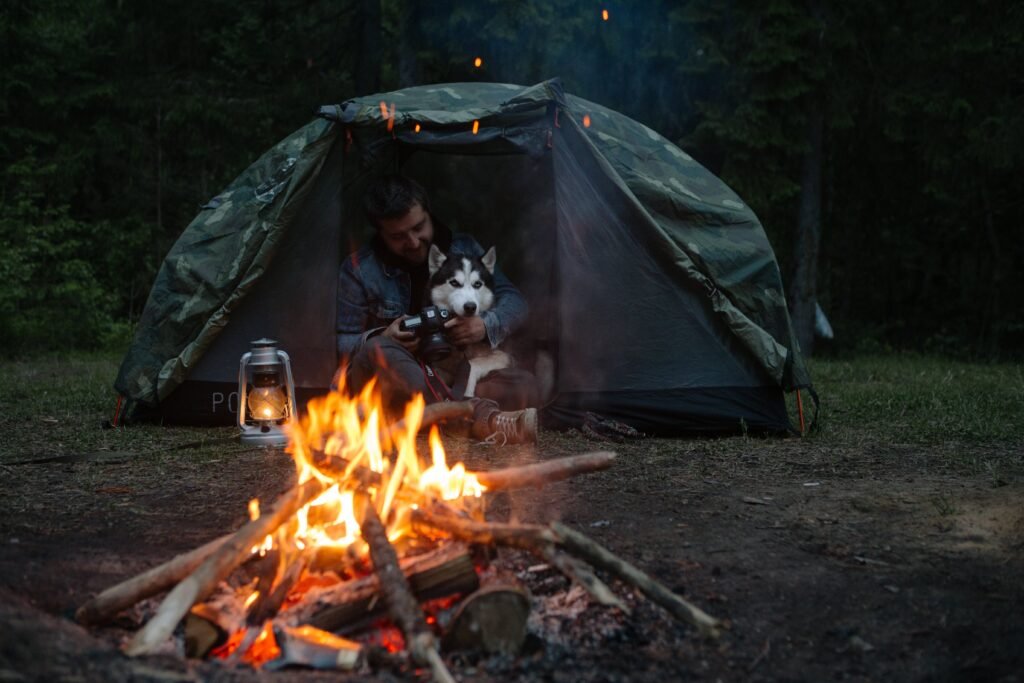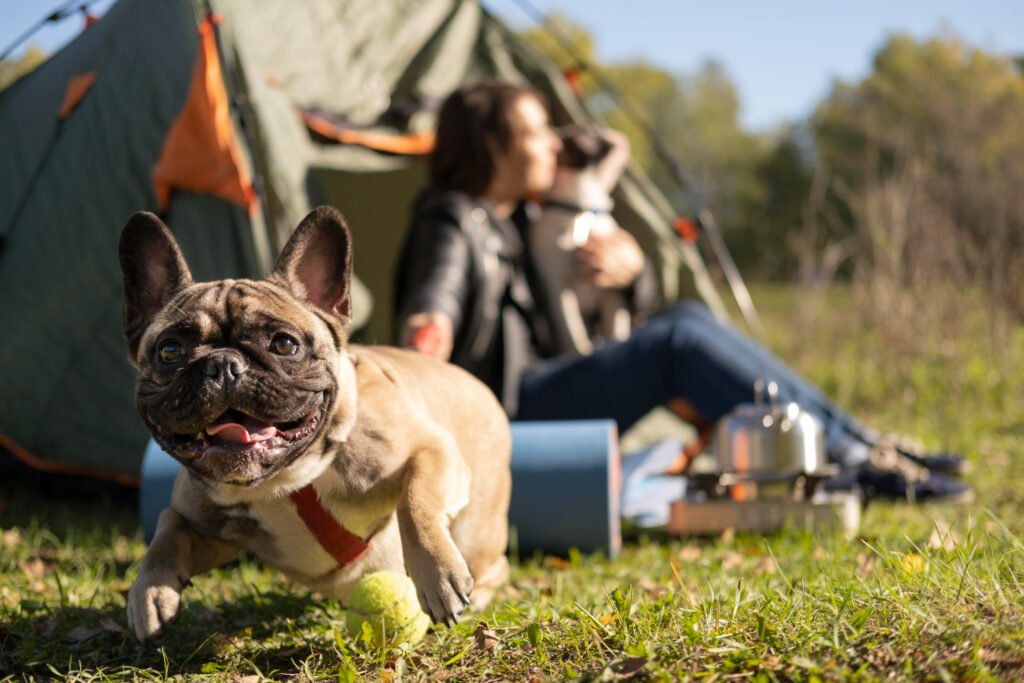Adventure is calling! But there’s just one problem. Who’s going to take care of your dog while you’re away? Instead of desperately searching for a pet sitter or doggy hotel, why not take your beloved fur kid on the adventure with you? Camping with dogs has a lot of layers to it, but we’re going to go through it all.
Camping with dogs is all the rage at the moment. It has become an increasingly trending subject on social media. After all, who could resist traversing the great wilderness with your dog by your side?
Of course, it’s not as simple as grabbing a leash and your pooch and calling it a day. Camping with pets takes meticulous planning and preparation. But that doesn’t mean that it’s a hassle. We’re here to give you the run-down on what you’ll need to make your dog your permanent adventure buddy.

A Comprehensive Guide for Camping with Dogs
Are you ready to learn everything there is to camping with dogs? Let’s get started!
Getting Your Dog Ready for the Great Outdoors
Embarking on a camping trip with your furry best friend can be an exhilarating and rewarding experience. But it’s not for the faint of heart. There are plenty of things to think about before going camping with your do. Not just for your ease of mind but to ensure that your pet is happy and comfortable. As we’ve said, it’s not as easy as grabbing a leash and heading into the wild. You’ll need to put some time and effort into preparing your dog for the great outdoors. Don’t worry. We promise the reward is worth it.
Is My Dog Made for Camping?
Not all dogs are built for the great outdoors. This comes down to a lot of different factors. Your dog’s breed, age, and personality determine what environments they’ll be comfortable in. Remember, every dog is different, just like people, and they have their own quirks and character flaws. As an owner, you need to assess your dog and see whether they’d be suited to camping. You’ll need to consider several personality and health traits to determine whether your doggo is fit to join you. Here are a few things to think about:- Is my dog anxious?
- Does my dog have health problems?
- Is my dog well-behaved?
Your dog is counting on you to keep them happy, healthy, and safe, so you must decide whether your precious furry family member is built for an excellent camping adventure.
Camping With Dogs is a Skill Easier Learned from a Young Age
Whoever said, “Old dogs can’t learn new tricks,” wasn’t entirely crazy! When training your dog to become your long-term camping buddy, getting them started young is always best. This will allow you to condition your dog for all the new, exciting, and terrifying things they might encounter while camping.
We recommend you start the experience at home, in your backyard. Expose your dog to the basics of camping slowly, and where necessary, correct their behavior. Get them used to the equipment, make sure they won’t chase after every squirrel they see, and ensure you’ve got good command over them.
Remember, when you’re camping, everything is new to them! Untrained dogs can get up to all sorts of naughty behaviors when let off-leash on a camping trip. The last thing you want to deal with is angry rangers or an emergency vet trip!
Depending on the type of camping you usually do, you’ll know exactly what training your dog will need to get used to the sights, smells, and experiences.
This training process is more straightforward during puppyhood, but with more time and elbow grease, your rough and rugged old shelter dog can also make a great camping companion.

Packing Your Doggy Camping Equipment
Once you’re confident your dog can join you on a camping adventure, it’s time to start preparing a dog-specific packing list. Your dog’s needs differ from yours, and you’ll need to cater to them accordingly.
This could sometimes mean making a few changes to the camping equipment needed. Switching out your teepee for something a little more fido-friendly is a good start. But for the most part, you can get away with minimal changes to your camping gear, just a few additions of the necessities.
Here’s a list of the absolute basics.
- Collapsible Food and Water Bowls
- Food
- Drinking Water
- Blanket or Doggy Sleeping Bag
- Poop Bags
- Leash and Harness
- Training Treats
- Toys
- Pet Tracking Device
Early Precautions To Consider When Camping With Dogs
Before you even reach the campsite, there are some precautionary steps to ensure your pet is kept safe when camping.
Tick, Flea and Worm Prevention
While all pet owners are drilled to use tick and flea prevention, it’s even more critical when you take them camping! Ticks and fleas are prevalent in the wilderness, and they won’t hesitate to take up residence in your dog’s fur. And don’t get us started on the dangers of worms!
These preventions ensure your dog remains comfortable and help prevent them from picking up illnesses like Lyme Disease and Heartworm. Speak to your local veterinarian for the safest option for your pet.
Vaccinations
Vaccinations are essential to help our pets avoid deadly illnesses. When you take your dog camping with you, they’re exposed to plenty of new and exciting things and can come face-to-face with local wildlife that carries vaccine-preventable diseases like rabies or canine distemper.
Health and Medication Checks
Finally, you need to make sure your dog can manage the trip. Taking them for a medical check can help ensure your dog has no underlying conditions that could play up while you’re away. It also means that if they have a manageable disease, you can top up their medication before you hit the trails.

How To Keep Your Dog Safe in the Wilderness
This isn’t your backyard. There are dangers in the wilderness you need to know about for your dog’s safety. Let’s take a look at what you need to know.
Wildlife Outside of Camp
In an ideal world, your dog should never run towards wild animals. Even though a small deer seems harmless, they are able to cause quite a fair bit of damage, if not transfer diseases to your pet. Unless you have impeccable recall and heel-stay training, keeping your dog on a leash is always the best precaution in environments with wild animals. This is especially true if your dog is reactive. The last thing you want is for your dog to shoot off into the woods after an invisible animal! And where you’re having a close encounter, a leash allows you more control of the situation.
Wildlife Inside of Camp
To avoid attracting any wildlife to your campsite, we’d recommend keeping your pets’ food tucked away somewhere safe and in an airtight container unless it’s feeding time. Coyotes, raccoons, possums and other opportunistic wildlife might be tempted by the standing food and might become aggressive towards you and your pet if you’re nearby.
Toxic Plants
We know trying to keep your dog from snacking on foreign objects he finds on the floor is like trying to stop a toddler’s grip. You’ll be wrestling your dog like Steve Irwin on a crocodile, trying to pry their jaws loose!
This is an unfortunate downside to outdoor adventures. Toxic plants are everywhere! We don’t expect you to know that the delicious-looking red berries on Dogwood and Holly are highly toxic. So you need to keep an extremely close eye on what your dog may be chewing on. Try your best to prevent them from eating anything you have not personally given them.
You can take a look at our Toxic Plant Guide here to get a better idea of the most common toxic plants you could be facing when camping.

Dog Behavior Around Campsites
Camping etiquette is universal, and no matter where you are in the country or world, there’s a certain etiquette you and your dog are expected to follow.
Clean Up After Yourself
Poop bags are an essential part of your pet packing list for a reason! You must ensure you clean up thoroughly after your dog to avoid it becoming someone else’s problem. Just like you wouldn’t want to step in a strange dog’s mess (or your own dog’s mess, for that matter), your fellow campers share the same sentiments. Follow the “Leave No Trace” Principles, as outlined here.
Know How to Minimize Barking
Camping is supposed to be a tranquil escape for most, and incessant barking won’t be welcomed fondly. We can’t ever entirely stop our dogs from barking. It is, after all, how they communicate essential emotions. But through mindful training practices and distracting enrichment, you can minimize it.
Not Everyone is a Dog-Person
It’s a fact of life that not everyone likes dogs, and you need to be mindful of this when interacting with other campers. Don’t let your dog wander around unsupervised. They may end up bothering someone who isn’t thrilled to see them. If you want to give your dog freedom when camping, maybe make a leash zipline network around your camp. That way, they can wander without approaching other campsites.
The Benefits of Camping With Dogs
There are numerous benefits to going camping with dogs, not just for your pet, but for you too.
It Helps Strengthen Your Bond
Your dog is as much a part of the family as your partner and kids, so it goes without saying that they’ll always want to be a part of the action! Taking your dog camping brings about unique opportunities to establish a strong bond. After all, you’ll be spending plenty of one-on-one time exploring the surrounding area, which builds trust and camaraderie.
Camping Helps Enrich Your Dog
Dogs need mental stimulation in order to stay happy and healthy. Your dog will be exposed to a new environment, with new stimuli like sights, smells and sounds. It removes monotony from the equation and gives your dog the opportunity to behave more like its wild self, which is a surprisingly useful training tool! By taking your dog camping, you’ll be able to desensitise them to new situations and have a calmer, happier pooch for it.
You Can Help Improve Your Dog’s Physical Health
Camping goes hand in hand with outdoor activities like hiking. We all know that taking your dog for regular runs and walks is part of the owner’s manual when you adopt them! So it goes without saying that heading on a camping trip and taking your dog on all your hiking adventures will help them improve physically. It helps build muscle tone, maintain healthy body weight, and help improve heart and lung function. All the benefits you get from exercise are similar for your dog and lead to a happy, healthy life.

Frequently Asked Questions
Here are some frequently asked questions about camping with dogs:
Is Camping With Dogs Possible Anywhere?
Unfortunately, you can’t always take your dog camping with you, as some State Parks and campgrounds have rules prohibiting it. Be sure to do your research to make sure your dog is allowed to go with you.
What Should I Do If My Dog Gets Lost While Camping?
You should immediately inform the Park authorities and start searching the area. You should leave food and water where they were last seen and a worn item of your clothing so they have a scent to follow.
Can I Leave My Dog Alone at the Campsite?
It would be best to never leave your pet alone at the campsite. When camping with your dog, they should always be supervised.
Conclusion
Camping is more than just pitching a tent. It’s about creating lasting memories, destressing, and creating a strong relationship with nature. So it only seems fitting that your furry family members get to join in the fun. Big or small, it doesn’t matter. If your dog is the loyal companion we know it to be, it’ll be more than happy to become your camping buddy!
So now you know the ins and outs of camping with your dog, it’s time to unleash adventure and head into the wilderness for wagging tails and happy trails!

